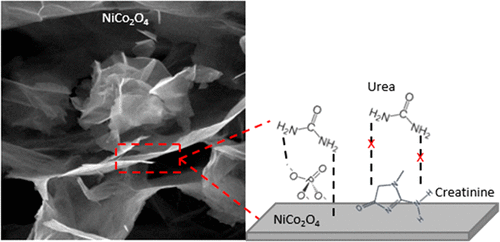当前位置:
X-MOL 学术
›
Environ. Sci. Technol.
›
论文详情
Our official English website, www.x-mol.net, welcomes your feedback! (Note: you will need to create a separate account there.)
Effect of Urine Compounds on the Electrochemical Oxidation of Urea Using a Nickel Cobaltite Catalyst: An Electroanalytical and Spectroscopic Investigation
Environmental Science & Technology ( IF 11.4 ) Pub Date : 2018-07-17 , DOI: 10.1021/acs.est.8b01743 Andrew Schranck 1 , Randal Marks 1 , Elon Yates 2 , Kyle Doudrick 1
Environmental Science & Technology ( IF 11.4 ) Pub Date : 2018-07-17 , DOI: 10.1021/acs.est.8b01743 Andrew Schranck 1 , Randal Marks 1 , Elon Yates 2 , Kyle Doudrick 1
Affiliation

|
Cyclic voltammetry (CV) and in situ attenuated total reflectance Fourier transform infrared (ATR-FTIR) spectroscopy were used to investigate the effect of major urine compounds on the electro-oxidation activity of urea using a nickel cobaltite (NiCo2O4 ) catalyst. As a substrate, carbon paper exhibited better benchmark potential and current values compared with stainless steel and fluorine-doped tin oxide glass, which was attributed to its greater active surface area per electrode geometric area. CV analysis of synthetic urine showed that phosphate, creatinine, and gelatin (i.e., proteins) had the greatest negative effect on the electro-oxidation activity of urea, with decreases in peak current up to 80% compared to that of a urea-only solution. Further investigation of the binding mechanisms of the deleterious compounds using in situ ATR-FTIR spectroscopy revealed that urea and phosphate weakly bind to NiCo2O4 through hydrogen bonding or long-range forces, whereas creatinine interacts strongly, forming deactivating inner-sphere complexes. Phosphate is presumed to disrupt the interaction between urea and NiCo2O4 by serving as a hydrogen-bond acceptor in place of catalyst sites. The weak binding of urea supports the hypothesis that it is oxidized through an indirect electron transfer. Outcomes of this study contribute to the development of electrolytic systems for treating source-separated urine.
中文翻译:

镍钴矿催化剂对尿液化合物对尿素电化学氧化的影响:电分析和光谱学研究
循环伏安法(CV)和原位衰减全反射傅里叶变换红外(ATR-FTIR)光谱用于研究主要尿液化合物对镍钴矿(NiCo 2 O 4)催化剂。与不锈钢和掺氟氧化锡玻璃相比,复写纸作为基材具有更好的基准电势和电流值,这归因于其每电极几何面积的有效表面积更大。合成尿液的CV分析表明,磷酸盐,肌酐和明胶(即蛋白质)对尿素的电氧化活性具有最大的负面影响,与仅使用尿素的溶液相比,峰值电流降低了80% 。使用原位ATR-FTIR光谱对有害化合物的结合机理进行的进一步研究表明,尿素和磷酸盐与NiCo 2 O 4的结合弱通过氢键或远距离作用力产生作用,而肌酐相互作用强烈,形成失活的内球络合物。推测磷酸盐通过代替催化剂位点充当氢键受体来破坏尿素和NiCo 2 O 4之间的相互作用。尿素的弱结合支持以下假设:尿素通过间接电子转移而被氧化。这项研究的成果有助于开发用于处理分离尿液的电解系统。
更新日期:2018-07-18
中文翻译:

镍钴矿催化剂对尿液化合物对尿素电化学氧化的影响:电分析和光谱学研究
循环伏安法(CV)和原位衰减全反射傅里叶变换红外(ATR-FTIR)光谱用于研究主要尿液化合物对镍钴矿(NiCo 2 O 4)催化剂。与不锈钢和掺氟氧化锡玻璃相比,复写纸作为基材具有更好的基准电势和电流值,这归因于其每电极几何面积的有效表面积更大。合成尿液的CV分析表明,磷酸盐,肌酐和明胶(即蛋白质)对尿素的电氧化活性具有最大的负面影响,与仅使用尿素的溶液相比,峰值电流降低了80% 。使用原位ATR-FTIR光谱对有害化合物的结合机理进行的进一步研究表明,尿素和磷酸盐与NiCo 2 O 4的结合弱通过氢键或远距离作用力产生作用,而肌酐相互作用强烈,形成失活的内球络合物。推测磷酸盐通过代替催化剂位点充当氢键受体来破坏尿素和NiCo 2 O 4之间的相互作用。尿素的弱结合支持以下假设:尿素通过间接电子转移而被氧化。这项研究的成果有助于开发用于处理分离尿液的电解系统。


























 京公网安备 11010802027423号
京公网安备 11010802027423号